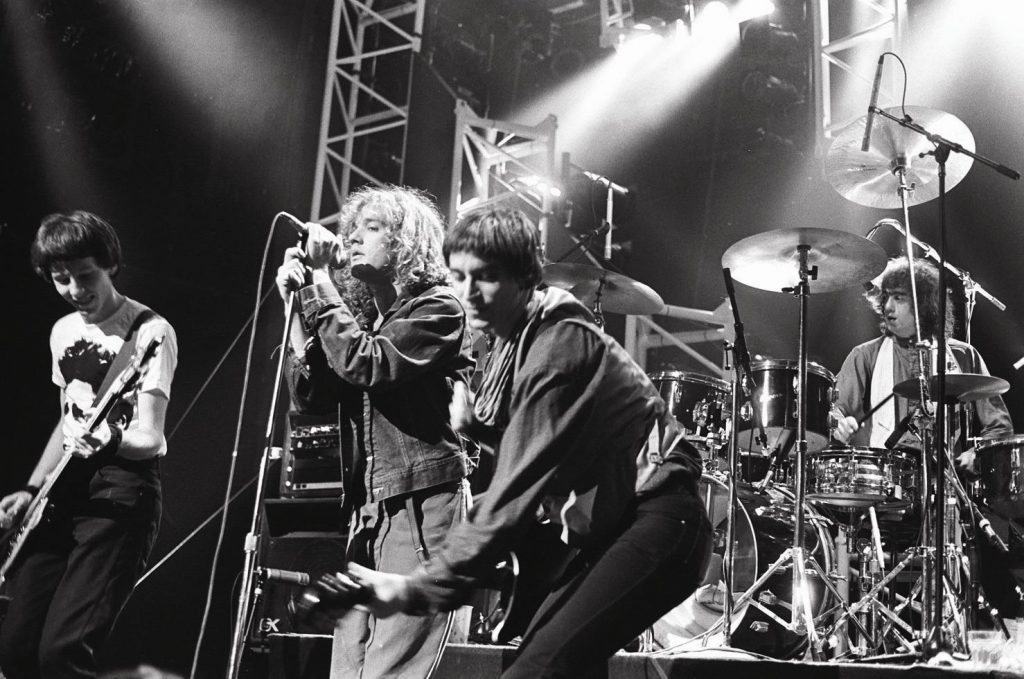
A college campus in the early 1980s was an interesting time to become aware of “pop” music. To clarify, I knew it existed, I just didn’t listen to any until I got to college in 1982.
The musical environment of the home I grew up in was heavy on classical, leavened with Broadway cast albums and a bit of jazz. The musical environment of the community where we lived was saturated in what we now call “classic country” and bluegrass, neither of which I had an appreciation for at the time.
Sure, the sounds of mainstream FM radio were all around, but I had what I considered a healthy and justified disdain for all that. (As I wrote here, I came to an appreciation of Bruce Springsteen much later). But college, and college radio, was ear-opening.
Friends in my dormitory introduced me to metal pioneers Black Sabbath and Led Zeppelin but also the so-called “New Wave of British Metal” from Iron Maiden, Judas Priest, Motorhead, Saxon, and the like. Other friends were my gateway to punk: The Clash, Buzzcocks, Sex Pistols, Dead Kennedys, Ramones, Siouxsie and the Banshees, Stiff Little Fingers.
MTV, which had debuted less than a year earlier, was a constant presence on the television in my dorm’s common room. (Yes kids, back in my day the only television in the dorm was in the common room. Deciding what to watch was an exercise in diplomacy and compromise.)
Our little college radio station, WLVR, opened up even broader musical horizons. By our senior year, a buddy and I were hosting a drive-time Friday morning show. Our musical choices were … eccentric.
R.E.M. is one of the bands that hit my consciousness back then like a thunderclap and has stuck with me ever since. And while there’s no end of songs I could single out in this space, I want to point to one, Driver 8, which captures for me nearly everything I love about the band, especially in its early years.
Driver 8 was the second single off the band’s third album, Fables of the Reconstruction, released in September 1985. In a long appreciation of the song posted at PopMatters, Robert Loss writes:
What if the song’s dream is about mobility? Freedom not as an ideal, but as the tangible freedom to move about, which might also mean the ability to participate, to argue, to be heard, to vote? Someone living in cities, plugged into the circuitry of the American Wow, might scoff at the uniqueness of this, but if you live somewhere else—a small town in the South, or anywhere remote; a dusty town in Kansas or a snowbound Montana mountainside village—it might be a breathtaking idea. So breathtaking that when the opportunity arises, you jump at the chance.
That’s how the song starts: a headlong jump forward, springing from one of Peter Buck‘s signature guitar melodies. The riff begins with a heavy downbeat, then races ahead, climbing, stumbling into syncopation, and just when it seems to have reached its zenith, it reaches a little higher before tumbling, and beginning all over again. The entire song has that impulsive feel, light and fleet, shuffling along on Bill Berry‘s simple backbeat and Buck’s arpeggiation, barely weighted by Mike Mills’ punctuated bass lines and the melancholy in Stipe’s voice.
Like so many of R.E.M.’s songs, from “Chronic Town” through “Document”, including the album this song originally appeared on in 1985, Fables of the Reconstruction, “Driver 8” entwines words within the whole of the song. Stipe’s vocals barely stand out above the guitars and his delivery is almost off-hand, as if you just happened to catch him singing. It’s not that the words’ meanings don’t matter, but if you’re looking for a clear story, you won’t find one. You’ll catch images and hear flashes of dialogue instead, and sometimes even those are willing to risk coherency, for example, “He piloted this song in a plane like that one”. We hear this for the pleasure of the sound, for the emotion and beauty of the sum. …
“Driver 8” suggests a story more than it tells one, and it’s probably more correct to say that it suggests many stories. The people who live them in the song speak quickly, or someone speaks for them, about them, or they say the same thing over and over—the conductor’s words to the driver, which you can hear growing more insistent—and some don’t speak at all. (What does the woman “selling faith on the Go Tell Crusade” have to say about herself? Would she call it “selling faith”?) They’re a loosely defined community, which is to say, a nation, bound together by what can seem like not much at all, but bound together nonetheless.
I actually included the official video release at the end of a post I wrote back in the spring of 2017, having been exhausted by the first three weeks of the then new Trump administration. I needed it as a mental break from what was then and has remained a virtually nonstop barrage of norm-breaking assaults on both democracy and basic human decency.
So here we are, almost three years later, and I still need this song. Driver 8, recorded live at the Capitol Theater in Passaic, NJ, in June 1984.